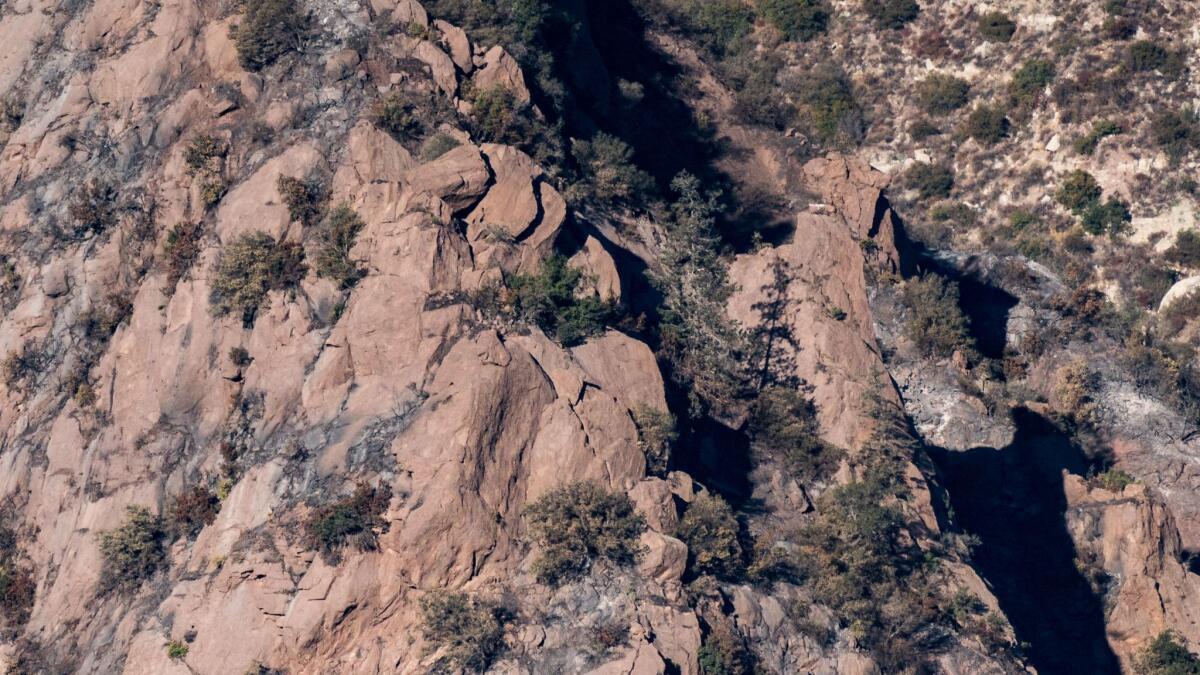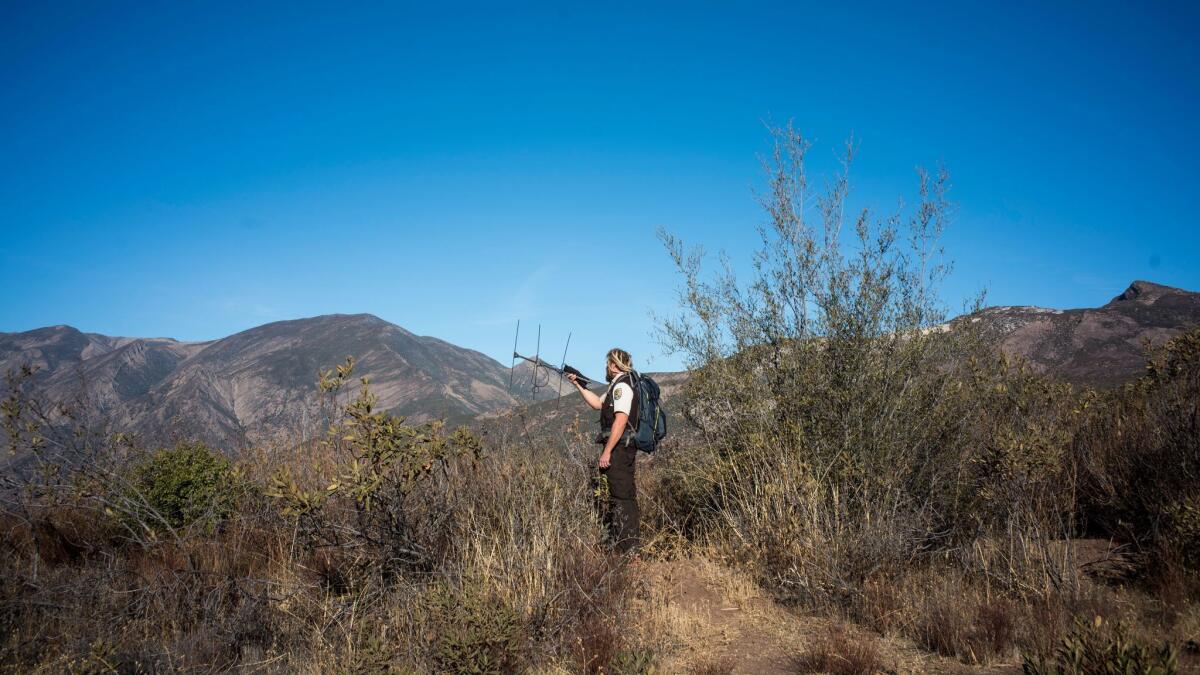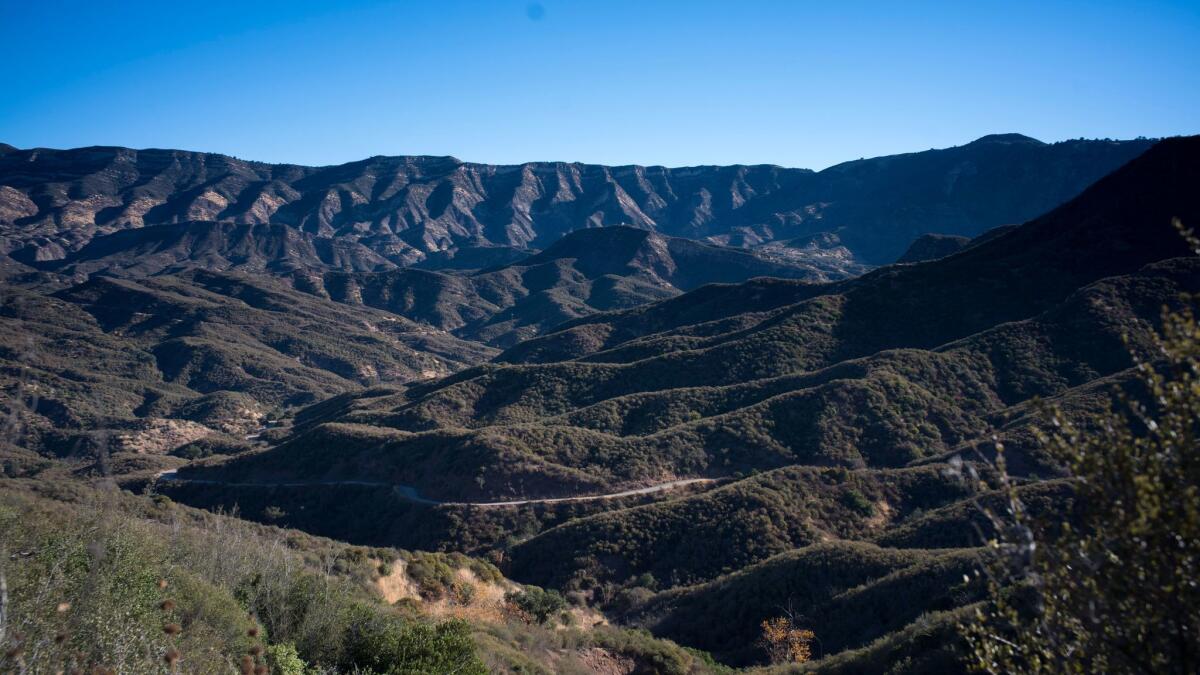Scientists search for survivors after the Thomas fire scorches a condor sanctuary

- Share via
Reporting from FILLMORE, Calif. — Pushed by instinct and age, a fledgling California condor had been expected to step to the edge of its cliff-side cave sometime in December and, with black-and-white wings flapping hard, make its first flight over the scrubby terrain of the Los Padres Sespe Condor Sanctuary.
But then the Thomas fire broke out.
The blaze ripped across Los Padres National Forest and into the 53,000-acre sanctuary, where 80 of the state’s 172 free-flying condors spend much of their time.
On Dec. 15, the 11th day of the fire, scientists lost contact with a radio transmitter attached to the turkey-size chick known as No. 871 as flames raced toward its closet-size cave. Days later a biologist chaperoned by a strike team from the California Department of Forestry and Fire Protection picked up a faint ping with an uneven tempo coming from the vicinity of the condor’s nest, but the findings were inconclusive.
At sunrise Wednesday, a team of biologists armed with telemetry equipment fanned out across charred wilderness that had been closed for weeks northeast of the community of Fillmore on a mission to pick up signals that could, perhaps, lead them to the 4-month-old condor, or its carcass.
With a 9 1/2-foot-wingspan, the federally endangered California condor is the largest scavenging bird in the nation and a symbol of both a species on the brink of extinction and successful, yet still precarious, efforts to restore imperiled populations.
The biologists tried to remain optimistic. The young bird and its parents — No. 513 and No. 206 — were descendants of a species that has survived since the Pleistocene Age of a million years ago.
But as the Thomas fire grew to become the biggest in California history, there was reason for concern.
Before barging through dense, thorny brush with a telemetry antenna held high, U.S. Fish and Wildlife Service biologist Joseph Brandt took stock of a worrisome scene on the far side of a scorched canyon overlooking Sespe Creek. Peering through binoculars, he saw splotches of red fire retardant on nearby ridgelines and a few smoldering hot spots. “The fire burned right up to the entrance of the condor cave,” he said.

It would not be the first time geographically isolated condors were wiped out in severely burned areas. Wildfires have taken the lives of seven condors that were part of the federal recovery effort since 1992, Brandt said. “Nearly all of them burned up when fire roared through their roosting areas at night.”
As he spoke, Nadya Sealfaith, a condor technician at the Santa Barbara Zoo, detected good news with a hand-held antenna.
“I’ve got a strong signal — and it’s from 871,” she said. “It’s coming from the canyon bottom north of the cave. So, she’s alive and moving.”
The question was whether she would stay that way.

Fledgling condors typically don’t get very far — and often crash land — on their first flight, Brandt said, leaving them vulnerable to predators. They also rely on their parents for a year or longer to find and bring back food.
And though adult condors are protective, they might abandon a chick if smoke and ash from a fire become too intense, scientists say.
The mission quickly took on two goals: Find the chick and, if possible, find her parents.
The team of trackers split into two groups, each tramping down no-nonsense trails in the wilderness set aside for endangered species including condors, arroyo toads, red-legged frogs and steelhead trout.
Condors have been in jeopardy since the 1950s, when development began to encroach on the species’ habitat, and the now-banned pesticide DDT made condor eggshells so thin they often could not support life.
Some of the huge birds were shot or died of lead poisoning when they fed upon the carcasses of other animals killed with lead shot and bullets.
Scientists began recovery efforts by capturing the few remaining wild condors, breeding them in captivity and releasing the birds in their historical range. Today, the population worldwide is 485.
Some of them soar over Ventura County, the Grand Canyon, the Sierra Nevada foothills and Baja California. For the first time in nearly four decades, condors are roosting about 40 miles west of Yosemite National Park.

Others are in captive breeding programs. Condors born and bred in captivity and released into the wild must frequently be trapped, then tested and treated for lead poisoning.
If the population continues to grow at current rates, the vulture that scientists know as Gymnogyps californianus may be eligible for down-listing from endangered to threatened within a few decades, researchers say.
At 12:30 p.m. on Wednesday, the biologists’ hand-held radios crackled with evidence that was testament to what hard work, passion and the resiliency of nature can accomplish. It was the beacon of the mother and father, picked up by Sealfaith as she stood by a cliff edge.
In the distance, she saw the birds.
“They’re circling over the nest in search of their chick,” she said over the radio.
“Great news,” Brandt said. “In about five years, 871 will be teaching her own offspring to soar.”
More to Read
Sign up for Essential California
The most important California stories and recommendations in your inbox every morning.
You may occasionally receive promotional content from the Los Angeles Times.











